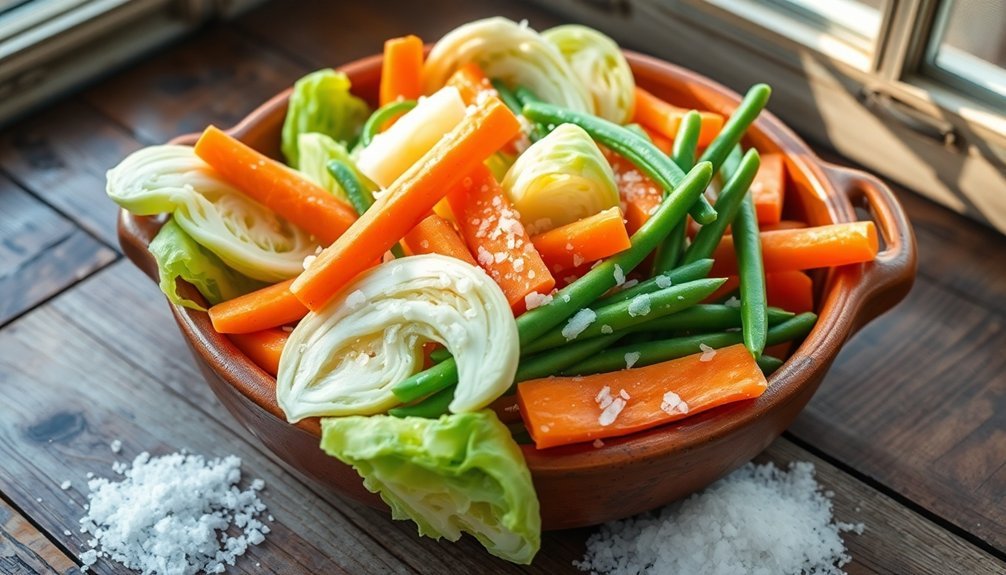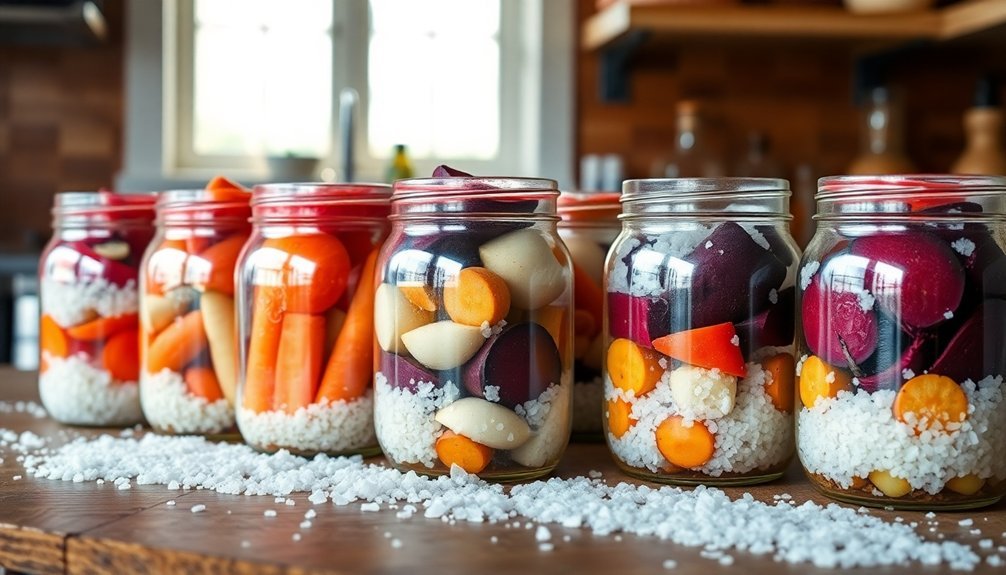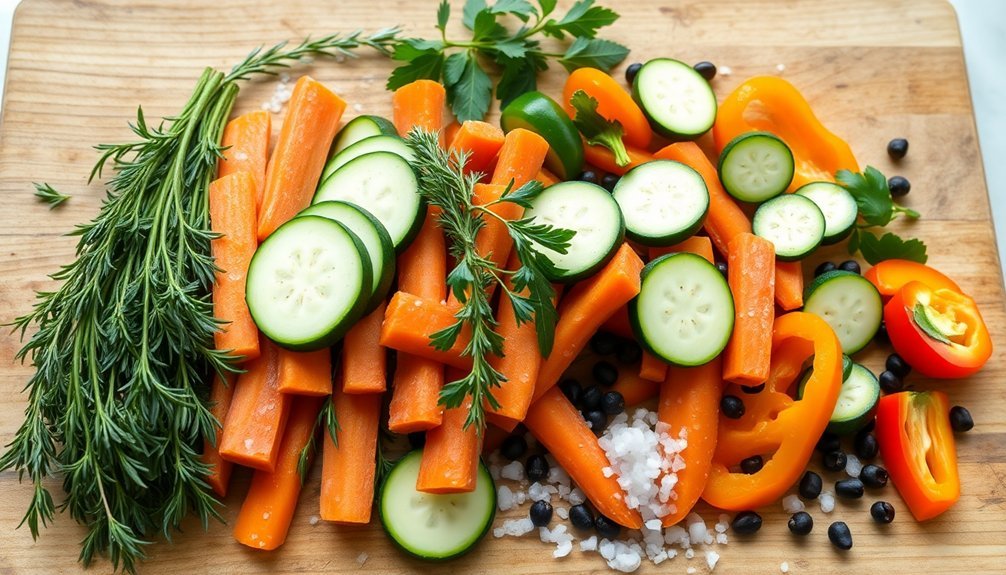You can preserve your winter vegetables using five reliable salting methods. Try the simple dry salt method by kneading vegetables with 2% salt until they release moisture. For lacto-fermentation, submerge cut vegetables in a salt brine solution and let them naturally ferment. Root vegetables stay fresh when packed in layers with salt and stored in clean jars. Cold brine pickling combines vinegar and salt for a tangy preservation method that works great with cucumbers. Finally, create herb-infused salt preserves by alternating layers of fresh herbs and salt. Each technique offers unique flavors and textures worth exploring in your preservation journey.
Simple Dry Salt Method

While many preservation methods exist, the simple dry salt method stands out as one of the most straightforward ways to preserve vegetables for winter.
You'll need to start by thoroughly washing your chosen vegetables and letting them dry slightly to reduce their moisture content. Then, slice, shred, or grate them to create more surface area for the salt to contact. This method effectively inhibits bacterial growth and extends shelf life significantly.
Calculate the amount of salt you'll need based on your vegetable weight – typically 1.5% to 2% of the total weight. Use coarse or pickling salt, avoiding table salt with additives.
Mix the salt thoroughly with your prepared vegetables, using your hands to knead them until they begin to soften and release moisture.
Place your salted vegetables in a sunny, well-ventilated area. You'll need to turn them regularly and pour off any liquid that collects.
Watch for signs of proper drying, such as slight shrinkage and surface wrinkles, while ensuring the vegetables remain pliable.
Once dried, store your preserved vegetables in clean, non-reactive containers in a cool, dark cupboard. Don't forget to label and date each container for proper rotation.
Traditional Lacto-Fermentation
Lacto-fermentation kicks off a natural preservation process that transforms ordinary winter vegetables into probiotic-rich delicacies.
You'll start by selecting seasonal vegetables like carrots, beets, radishes, and winter squash. Cut them into bite-sized pieces and remove any thick peels, especially from winter squash. You can leave some unpeeled parts to provide natural starter cultures. Salt draws moisture from the vegetables during preparation, helping create the perfect environment for fermentation.
To create the brine, mix 2 grams of salt per 100 mL of water, using natural salt without additives. Add your chosen flavorings like garlic, dill seeds, or horseradish.
Pack your vegetables into clean containers and pour the brine over them, making sure they're completely submerged. Press out any air bubbles and use weights or airlocks to keep everything below the brine level.
Keep your fermentation at 68-72°F for ideal results. The process can take several days to weeks, depending on your taste preference.
Once fermented, your vegetables will be easier to digest and packed with probiotics, vitamins, and minerals. Store them in a cool, dark place and check regularly to confirm they stay submerged in the brine.
This method not only preserves your winter vegetables but enhances their nutritional value.
Root Vegetable Salt Making

Through generations of traditional practice, root vegetable salt making has emerged as a reliable preservation method that begins with careful vegetable selection and preparation. You'll need to select unblemished root vegetables, scrub them thoroughly, and maintain their protective skins whenever possible. The process typically requires 7 to 10 days for complete fermentation to develop optimal flavors.
When you're ready to start the process, create a brine solution by mixing 1-2 tablespoons of salt per quart of non-chlorinated water. Layer your vegetables in a clean jar, adding salt between layers while firmly packing them down with a kraut pounder to release their natural juices.
| Step | Action | Key Point |
|---|---|---|
| 1 | Prepare Vegetables | Keep skins intact, remove stems |
| 2 | Make Brine | Use non-chlorinated water |
| 3 | Pack Layers | Add salt between layers |
| 4 | Cover | Keep vegetables submerged |
| 5 | Store | Maintain 60-75°F temperature |
You'll want to leave 1-2 inches of headspace at the top of your jar and guarantee the vegetables stay completely submerged under the brine. Store your ferment in a dark place at 60-75°F, checking regularly for pressure buildup starting around day three. Once your vegetables reach your desired flavor profile, transfer them to refrigeration for long-term storage.
Cold Brine Pickling
Cold brine pickling offers a simple yet effective method for preserving vegetables without the need for heat processing.
You'll need pickling cucumbers or other suitable vegetables, which you'll need to trim at the blossom end to prevent cloudiness. Cut your vegetables into your preferred shapes – spears, slices, or chunks – and ascertain they're thoroughly cleaned.
To create the cold brine, mix 8 cups of cold water with 1/2 cup of white distilled vinegar (5% acid) and 1/3 cup of canning salt until completely dissolved. You can substitute coarse kosher salt if needed. There's no heating required, and you can prepare the brine ahead of time.
Start by distributing your chosen spices and aromatics among clean jars. Pack your prepared vegetables into the jars, then pour the cold brine over them, leaving 1/2-inch headspace.
Cover the jars loosely with a cloth or paper towel and let them sit for 24 hours at room temperature.
After the initial rest period, transfer your jars to the refrigerator and wait at least three days before tasting. Your pickles will keep for up to six months when properly refrigerated with airtight lids.
Herbed Salt Preservation

Preserving fresh herbs in salt offers one of the oldest and most reliable methods for maintaining their vibrant flavors throughout winter.
You'll want to start by selecting fresh herbs at their peak, avoiding any yellowed or damaged leaves. After washing and thoroughly drying your herbs, remove tough stems while keeping the tender ones intact.
Begin the preservation process by placing a layer of salt at the bottom of a clean, sterilized jar. Layer your herbs and salt in alternating levels, maintaining a ratio of roughly 4 parts herbs to 1 part salt.
As you build the layers, gently shake the jar to eliminate air pockets and guarantee even salt distribution. Always finish with a thick salt layer on top before sealing the jar tightly.
You can store your preserved herbs either in the refrigerator or pantry, but you'll need to check them periodically for any signs of spoilage.
Give the jar an occasional shake during the first week to redistribute the salt. When you're ready to use your herbs, simply brush off the excess salt or give them a quick rinse.
The preserved herbs will maintain their flavor for up to a year, and you can even use the flavored salt in your cooking.
Frequently Asked Questions
Can I Reuse the Brine From Previous Fermentation for New Batches?
Yes, you can reuse fermentation brine for new batches! It'll serve as a starter culture, adding beneficial bacteria and flavor. Just add 1/2 cup per quart jar and top off with fresh brine.
How Do I Prevent Kahm Yeast From Forming on My Fermented Vegetables?
You'll prevent kahm yeast by maintaining proper salt levels (2% brine), minimizing oxygen exposure, keeping vegetables submerged, using sterile equipment, and storing ferments at cool temperatures below 68°F (20°C).
Why Do Some Vegetables Float to the Top During Fermentation?
Your vegetables float when they're not properly submerged in brine or lack enough extracted juices. You'll see this happen if you haven't weighted them down or if there's intense fermentation activity.
Should I Wash Vegetables Before Salting if They're From My Garden?
Yes, you'll need to wash your garden vegetables before salting them. Use clean water to remove dirt, debris, and potential bacteria. Just avoid soaking them too long to prevent waterlogging before the salting process.
Can I Mix Different Types of Vegetables in the Same Fermentation Jar?
You can mix compatible vegetables in the same jar. Try combining cauliflower with cabbage, or carrots with beetroot. Just make sure you don't mix incompatible combinations that could affect texture or fermentation.
In Summary
You've now learned five reliable methods to preserve your vegetables through salting. Whether you've chosen the straightforward dry salt technique, traditional fermentation, root vegetable processing, cold brining, or herbed preservation, you're well-equipped to keep your harvest fresh for months. Don't hesitate to experiment with different combinations of vegetables and seasonings. You'll find these methods not only preserve food but enhance flavors naturally.





Leave a Reply